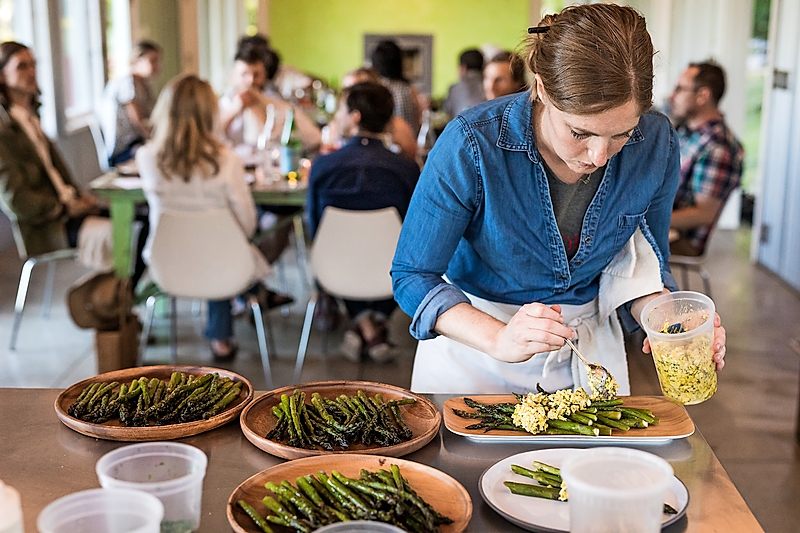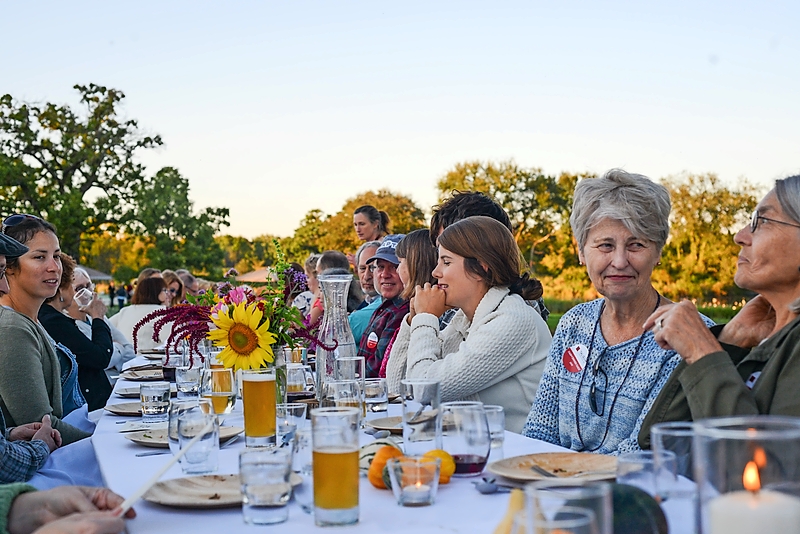Join the Table
By Naperville Magazine
July 2018 View more Featured

For many nine-to-fivers and overbooked families, the appeal of leaving it all behind for a simple, serene life on the farm is undeniable. That pull was so strong for Rachael Jones and her husband Chris that, in 2014, the couple parted ways with their office jobs in the city and uprooted their family of four from south suburban Homewood to rural Grant Park, Illinois. “We unlocked our dreams and visions of spending our days outside,” Jones says of the family’s life on the five-acre Locavore Farm.
Beyond the slower pace they craved, the intent was twofold: to grow food for their family and to be able to share the bounty with friends over meals on their land. In their first year, they accomplished both at Locavore.
Following that initial harvest, they had an epiphany: “We looked at our surplus and thought, ‘What if we built a longer table and invited more guests?’” Jones recounts. With that, they set to work building a 100-foot-long, 100-seat cedar table, piece by piece. They put the word out, and hosted their first public dinner in the spring of 2015. Since then, 5,800 people have dined at that idyllic table, and tickets to what’s become a monthly event at Locavore Farm have sold out well in advance.
Though the Joneses toiled long and hard to fulfill their vision, it reads like the Hollywood version of what many other farmers in the region have also done: rolled out the welcome mat and opened their kitchens to the public. Though many farms have a restaurant component, these ticketed meals take place elsewhere, be it in a hay-filled barn or on a white tablecloth out in the field. “We’re not just an outdoor banquet facility or a restaurant without walls,” Jones says. “This is modern-day agriculture.”
Structured farm dinners are not new, but they’ve never been more appealing. It makes sense, since public curiosity about farming has piqued, according to Abra Behrens, the chef at Granor Farms. “We’re [seeing] a pendulum shift, with people becoming more interested in farm culture,” says Behrens, who comes to the Southwest Michigan farm by way of Chicago’s culinary scene. “Our job as producers is to connect people with their food source and teach them how it’s grown.” Leslie Rusk of Fair Oaks Farm in Northwestern Indiana echoes these sentiments. “People feel comfortable knowing where their food comes from,” she says.
Even with the recent uptick in interest making buzzwords out of “local,” “sustainable” and “organic,” there is still a lack of public understanding when it comes to food production. This fact became glaringly obvious to third-generation farmer Louis-John Slagel of Slagel Family Farms when, during a meat delivery in the city, a customer asked whether the male chickens or the female chickens typically lay eggs.
Slagel says his Central Illinois farm has offered four-course dinners for seven years, and guests often tell him they’ve never seen a live pig. In fact, says Rusk of Fair Oaks, only two percent of the population even knows a farmer—a statistic she says the dairy farm hopes to change. Fair Oaks opens its doors to the public in order to bridge the gap between producer and consumer. “We want guests to see for themselves what modern agriculture looks like,” she says.
That’s why farm tours typically precede dinner, and guests are also invited to linger after the dishes have been cleared. At downstate farm Mint Creek, a two-hour immersive look at the 220-acre property and its livestock sets the tone for an evening that’s one part feast, one part education. Following the festivities, some make a night of it, either retreating to the neighboring bed and breakfast or camping beneath the stars. Dinner guests at Prairie Fruits Farm in Champaign are even encouraged to get up between courses and stroll through the garden, pick tomatoes or visit the creamery’s goats.
Locavore’s five-course meal concludes with live music and a marshmallow roasting. When all is said and done, Jones spends up to six hours with her dinner guests, opening their eyes to food production and encouraging them to soak up the zen of the farm. “There’s no better way to connect to your food than to eat it [right where] it was grown,” she says.
Another reason to ring the dinner bell: to showcase the Midwest’s embarrassment of culinary riches. Prairie Fruits began its communal dinners a decade ago in an effort to highlight the region’s bounty and, according to farm co-owner Leslie Cooperband, to show people that Illinois’ soil produces more than corn and soybeans.
Typically, an onsite chef like Granor Farm’s Behrens or a visiting farmer will prepare a family-style spread, showcasing hyperseasonal produce: You’d be hard-pressed to find a fresher meal. Other times, farms tap big-name chefs to make cameos. The farm-to-table movement means people like Slagel and Mint Creek’s head farmer Harry Carr work closely with the Chicago area’s top restaurant talent, and you’ll find the likes of Paul Virant (Vie, Vistro) and Ashlee Aubin (Salero) tending to the grill.
By lending star power to dinners, chefs are furthering relationships with and supporting their suppliers. But a Saturday on the farm is also a respite from the heat of the kitchen. Behrens, who recalls the kindnesses of fellow Chicago restaurateurs from her days in the city, says, “I feel I can repay the Chicago restaurant community by inviting them to this peaceful, beautiful place.”
Slagel says it’s also a boon for suburban guests, who, in essence, get to experience their favorite restaurants without the inconvenience of traveling to the city to dine. “We’re bringing the high caliber chefs right to them,” he adds.
The promise of a slow-paced, hassle-free meal makes guests decompress when they set foot on the soil. “I used to have anxiety about making every aspect of the meal perfect,” says Carr, who has done dinners at Mint Creek for the better part of a decade. “But people are just so happy to be here that they don’t care about the small stuff.”
So maybe the Jones’ full-fledged farm life isn’t for everybody, but you can certainly raise a glass to the majesty of the farm, experience the iconic flavors of the Midwest, and—for an evening—slow down.

Granor Farm
Three Oaks, MI
Asparagus with Sauce Gribiche
Yield: 2–4 people
1 pound asparagus
4 eggs, hard-boiled
1 shallot or small onion
1 bunch parsley
5 sprigs tarragon
1 lemon, zest and juice
¼ cup olive oil
salt and pepper
Trim asparagus and wash thoroughly.
Mince the shallot/onion and finely
chop the herbs.
Combine the shallot/onion, herbs, lemon zest and juice and olive oil with a big pinch of salt and black pepper.
Grate the cooked eggs on the largest
tooth of a box grater and combine with the onion mixture.
Coat the asparagus with olive oil, salt and pepper, then grill or roast until the outside is blistered and the color is bright green.
Plate the asparagus on a serving platter, top with the sauce gribiche and serve.

Heritage Prairie Farm
Elburn, IL
Kane County Crops
A mere 50 miles from downtown, a farm dinner at the quaint, pastoral produce powerhouse Heritage Prairie Farm is totally doable for date night or a group of friends (21+). Grab tickets ($90 to $100/person; heritageprairiefarm.com) for one of the themed monthly events and you’ll feast on USDA-certified organic veggies, meat, honey and more—all sourced from within yards of the table. This season’s lineup features a little something for everyone, from live music to local brews.
July 20
Cocktail Party
Dishes like tomato shortcakes and sautéed ricotta dumplings share the spotlight with specialty cocktails at this soiree, with a live band and bonus charitable component: Half the ticket price goes to Bridges Academy in St. Charles.
August 16
Honey & Beer
This annual celebration of a delicious—honey and beer—duo commemorates the hard work of the farm’s bees, and dishes like blistered tomato grits creatively incorporate
the sweet nectar. Pairings from Solemn Oath sweeten the deal.
September 13
Heirloom
It’s the last hurrah for much of the summer’s bounty, and this feast of heirloom fruits and veggies showcases the farm’s just-plucked goods, including blueberries, summer squash, melon and tomatoes.
October 11
Roots & Wine
Root vegetables (think beets, radishes, and celeriac) take center stage at this bonanza of fall flavors. And oenophiles, take note: each course gets paired with a glass of vino.
November 1
Friendsgiving
The season concludes with a Friendsgiving-themed smorgasbord. You’ll break bread (focaccia with honey butter, specifically) with loved ones and new pals, working your way through dishes like pumpkin and cauliflower gratin.

Taliesin Preservation
Spring Green, WI
Prairie-Style Feast
Get hungry, architecture buffs: Franks Lloyd Wright’s 800-acre former home, studio and school in southwestern Wisconsin is now a working agricultural estate offering tours, educational programming and—you guessed it—dining.
Wright made this hilly retreat his home in the latter part of his career, and in the 1930s, he formed Taliesin as a fellowship of architects and artists. So where does the culinary component tie in? “Wright was very much a farmer,” says the preservation’s events and design manager, Aron Meudt-Thering, who adds that Wright grew food both out of necessity (to feed those living at Taliesin) and hobby.
Wright also valued the communal aspect of dining. Every Saturday he would host a formal meal—complete with entertainment—for the artists, architects and other community members. To honor that tradition, Taliesin offers outdoor dinners, giving guests the opportunity to meander through 300 acres of organically certified farmland before sitting down to a four-course, family-style meal cooked by a visiting chef.
Taliesin farm dinners are hugely popular, and this year’s are already booked. But you can still score a taste of Taliesin’s bounty at the waterfront Riverview Terrace Café, where participants of the preservation’s work-study culinary program source ingredients onsite to create seasonally inspired meals.


